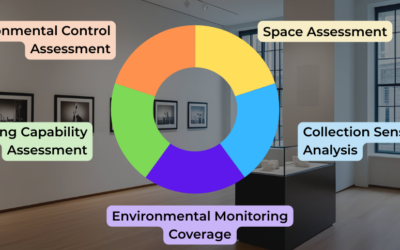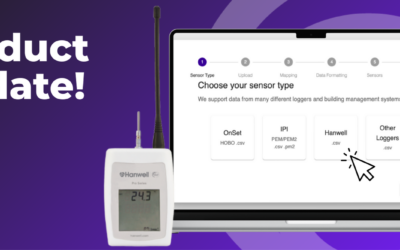Funding your environmental monitoring program
Collection stewards who take on preservation responsibilities have likely heard some version of the statement,
“environmental monitoring is one of the best ways to ensure the long-term preservation of collections.”
This sentiment is correct. Using environmental data to inform decisions about collections storage, access, and display is a great way to mitigate damage caused by many of the known agents of deterioration (ASHRAE, 2019).
The costs associated with setting up an environmental monitoring program, however, can be daunting, especially for those organizations with limited budgets and staff time. There are steps that collection stewards can take to advocate for funding both internally and externally through grants for environmental monitoring.
The cost of environmental monitoring
Whether your organization is budgeting internally for an environmental monitoring program or seeking grant funding, cost analysis is the first step.
There are three categories that environmental monitoring costs can fall into: equipment, services, and labor. (Calvi, 2006) It is important to consider all these categories when calculating costs.
Equipment cost includes the environmental monitoring equipment and any costs directly associated with that equipment. Those may include the cost of shipping and handling, maintenance, and spare parts and batteries. The price of environmental monitoring equipment varies based on sensors, accuracy, and other technical specifications.
Service cost includes everything related to data analysis and storage. When choosing a monitoring platform, consider features like environmental targets and performance reporting, mobile capabilities, and access to local weather data. Keep in mind that fewer capabilities and services offered by the platform often means more labor cost spent on monitoring, analysis, and reporting.
Labor cost is an important, but often overlooked component of environmental monitoring. Staff time spent gathering, uploading, analyzing, and reporting environmental data is included in labor cost. You may calculate the cost of monitoring by multiplying the percentage of staff time dedicated to monitoring per year by annual compensation. Online calculators like this one from omnicalculator.com, and Conserv’s Total Cost of Ownership Calculator can help in determining accurate labor costs.
An accurate cost analysis will help collections stewards advocate for funding internally and through grant programs.
The argument for internal funding
Funding environmental monitoring internally (even partially) is the most sustainable way to create a program. It ensures that collections stewards as well as other stakeholders like administrators are committed to environmental management. Collection stewards are often aware of the impact of environmental management, but other stakeholders sometimes need convincing to create precious space in budgets. There are several strategies that collection stewards can take when advocating for funding. (CCAHA, 2022)
Refer to organizational documents that include preservation. This may include your mission or vision statements as well as any long-term strategic planning. Emphasize that environmental management affects whole collections rather than just individual objects, so an investment in monitoring is an investment in the entire organization.
Cite the experts. The idea that extremes in temperature and relative humidity can cause damage to collections is backed by research. Cite authoritative organizations like the Canadian Conservation Institute, the Image Permanence Institute, and the American Society of Heating, Refrigeration, and Air Conditioning Engineers (ASHRAE) when making the case for environmental monitoring. Preservation Needs Assessments completed by outside assessors can also be used to reinforce the case.
Highlight less obvious benefits. Having an environmental monitoring program in place can affect whether organizations receive accreditation or are able to accept loaned objects. Monitoring programs can also lead to the implementation of energy saving strategies that lower energy costs and make organizations more environmentally sustainable. These are benefits that affect not only the collection, but the entire organization. (Ford et al, 2017)
Grant funding
Covering at least some of the cost of implementing an environmental monitoring program internally is preferrable, but there are grants that organizations can utilize to offset some of the startup costs, like the cost of dataloggers. An accurate cost analysis and some internal funding for the upkeep of the program is a great start. The recommendations included above on advocating for internal funding.
Find the right grant. There are grants that can fund environmental monitoring projects at the federal, state, and local levels, but it is important to find the one that best fits your organizational needs. Lists of grants that focus on preservation projects can be found in a few places online including the following websites:
- MACC’s active list of Federal, State, and Private grants and deadlines
- Fundraising Assistance through the Center for the Conservation of Historic Artifacts
- The American Institute for Conservation’s funding resources
Ask clarifying questions. If you are questioning whether a grant is right for you, or if you have decided to apply for a grant and need more guidance, reach out to the Grants Manager listed in the description. Grants Managers are often willing and happy to answer questions about eligibility, discuss projects, and even look over application drafts.
Make a solid argument. All the recommendations that apply to advocating internally for funding also apply to writing a compelling grant application. Remember that grant funders want to fund projects in institutions that provide some level of existing support to preservation projects, whether that is through staffing, funding, professional development, etc.
- Reference mentions preservation in core organizational policies.
- Note when internal funding is allocated to preservation projects.
- Cite preservation needs assessments or other documentation from outside assessors.
- Highlight communication efforts to publicize the project, which emphasizes your institution’s commitment to collections care as well as the work of the granting agency.
Key Takeaways
- Environmental monitoring and analysis is an effective way to mitigate risk of deterioration to cultural heritage collections.
- The cost of an environmental monitoring program includes equipment, service, and labor costs.
- Some internal funding for environmental monitoring programs is important to create a sustainable system.
- Advocacy is a powerful tool when looking to fund environmental monitoring programs both internally and with grant funding.
Works Cited
- American Society of Heating Refrigerating and Air-Conditioning Engineers. “Chapter 24: Museums, Galleries, Archives, and Libraries.” In ASHRAE Handbook: HVAC Applications, 2019.
- Calvi, Elise, and Association for Library Collections & Technical Services, eds. The Preservation Manager’s Guide to Cost Analysis. Chicago: Preservation and Reformatting Section, Association for Library Collections & Technical Services, 2006.
- Conservation Center for Art and Historic Artifacts. “Budgeting for Collections Care,” July 2022.
- Ford, Patricia, Peter Herzog, Jeremy Linden, James Reilly, and Kristin Smith. “IPI’s Methodology for Implementing Sustainable Energy-Saving Strategies for Collections Environments.” Rochester, NY: Image Permanence Institute (IPI), 2017.
Further Reading
- Cooper, Maddie. “Tips for Grant Funding Environmental Monitoring Projects.” Conserv (blog), April 29, 2021.
- Holtz Stanton, Laura. 2020. “Advocating for Collections During Challenging Times.” Webinar presented at the Connecting to Collections Care Webinar, Foundation for Advancement in Conservation, June 10.
- LYRASIS. 2008. “Preservation Budget Planning.” Preservation Services Leaflet. Atlanta, GA.
- Oregon Heritage Commission, and Sarah Baylinson. 2017. “Collections Budget Report: A Comprehensive Study of the Cost of Collections Care.” Oregon.





